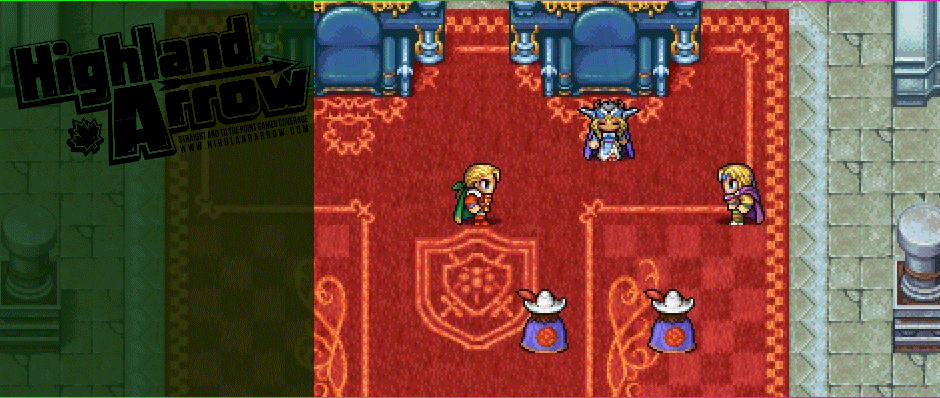

Final Fantasy 2
Platforms: NES/Famicon, GBA, PS1, PSP
Reviewed on: PSP
Reviewer: Trever Bierschbach
Review Play-Time: 30h
Developer: Square
Publisher: Square
Released: 1988-12-17
Review Published: 2020-05-12
Review Updated: 2021-06-06
+ Consistent art style and theme with updates over FFI
+ Game mechanic innovations to set it apart
+ Continues to incorporate non-traditional fantasy
+ More balanced encounters from the original
- Some predictable plot turns
- Leveling mechanics can inadvertently make late-game
weapons less useful
- While improved, combat can still become a tedious grind

Final Fantasy II is a Japanese-style RPG developed and published by Square. Final Fantasy II followed surprise success of Final Fantasy, literally named because Square believed it would be their last game before bankruptcy. How wrong they were. Final Fantasy II was not originally released in North America, which can cause some confusion among newer fans of the franchise. After the first game, we didn't see another release here until Final Fantasy IV, which was titled Final Fantasy II in North America. For the purposes of this review we are talking about the original Final Fantasy II that was first released in Japan exclusively. It has since seen remastered releases on multiple handheld and mobile platforms, as well as on the original Playstation. I played it myself on the PSP and later played an emulated version of the original.
Like most early Final Fantasy titles, this is more a sequel in theme rather than story. You can play most of the early games in any order, and skip around, or skip some entirely and you really don't miss anything related to story. This story follows an invasion which decimates the land. We start with four young heroes, whose parents were lost in the war, and three of whom join the rebellion against the Palamecia empire. The heroes are saved by a princess, who turns out to be a rebel leader, and they join up to fight the evil that has taken over the land.
Besides the new story, and the fact that you could only get this in Japan for quite a while, there's very little to differentiate this game from the first one. Some game play mechanics are different, which we'll touch on later, but other than that both games look and feel the same if you play the original versions. Of course, the remaster of this game for the PSP is quite a bit different. If you've seen the first game you wouldn't really be able to tell them apart in a side by side.
These Chickens are Huge!
Like I said, this game looks and feels almost exactly like its predecessor, except for a few changes to the mechanics. A lot of things were added to make the game easier to play, and some experimental things that wouldn't make it past this edition, were added. The developers managed to innovate the game, without completely changing what made Final Fantasy what it was to begin with.
New to the series, and most noticeable at first is leveling. Characters now level based on what they do, not experience. Characters get better with weapons as they use them, magic as they cast it, and so on. Unfortunately, this logical system allowed an unintended exploit that gave players the ability to max level their characters early in the game. Used correctly though, this system is interesting in that you could focus a character in either magic, or combat, and in the use of specific weapons, and see them specialize in that. It had the unfortunate side effect of almost railroading a character's development though, if you didn't mix things up. You might wind up finding end-game weapons that your characters just aren't good with because you focused on a different weapon type.
Another big change was combat. The combat panel looked different, and now displayed the monster's HP. The big addition though, was the back row. Putting characters in a position in which they were only at risk from ranged weapons and spells. It allowed you to almost form a sort of shield wall with your tougher warriors in front of your squishy casters. Combat becomes a little more tactical in this game, whereas in the last one you might find yourself often just spamming the A button to confirm the first default action. Combat is also made a little less stressful by the change in resting and saving. You still can't save in dungeons, but you no longer need cabins or tents to rest up and save the game in the overworld. That doesn't mean combat is much less tedious though. Sometimes you'll still find yourself just spamming the accept button.
Final Fantasy II is also the first appearance of the chocobo and a character named Cid, which will become the iconic features of every Final Fantasy game that comes after. These giant yellow chickens add a new method of travel in the overworld, along with the standard boats and airships we've already seen before. While Cid is a mainstay of the franchise, he's always a different person, though he usually has similar traits from game to game.
Story First!
In what seems like an unusual move by today's perceptions, the team at Square developed the story for this game first, and built everything else around it. It often feels like story is secondary in most games, but it was literally the primary concern here. Like the first Final Fantasy, the story in this installment is good, especially for its time. When a lot of games coming out had very little story, or just enough story to deliver the gameplay, Final Fantasy's team was delivering some thought-provoking complexity in a medium that was still considered 'for children' in much of the world. Of course, much of that can be contributed to the game's original market, where video games were taken a little more seriously.
The story in this game is more interesting than Final Fantasy I because of the obvious care that went into it. The story takes place during a war, similar to Star Wars, complete with rebel princesses and evil emperors. Unlike Star Wars, the story isn't about the unexpected everyman becoming the savior of the galaxy. The story isn't long compared to many RPGs, and it does rely on many predictable elements. The betrayal of a close friend, the boss who isn't really dead the first time you defeat him, and so on.
As predictable as parts of the story were, it was still worth experiencing even by today's standards. Even though the game looks nearly identical to the first, there are enough mechanical changes to give you a new experience. So far it has been a worthwhile experience to play through the early Final Fantasy games and see their evolution into what we have today. As I play through Final Fantasy III it reminds me why I fell in love with these games as a teenager, and how they influence much of my early understanding of fantasy storytelling.

